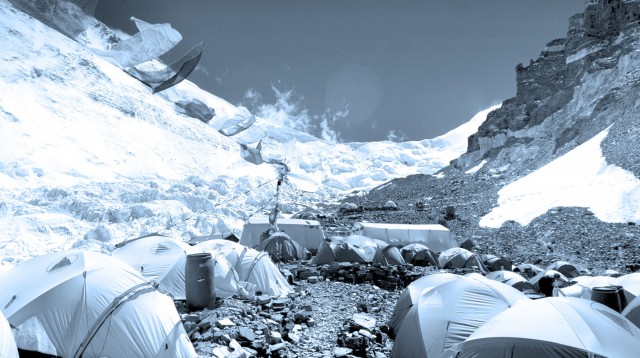
Arunima Sinha, 26, from the northern state of Uttar Pradesh, reached the peak on Tuesday morning after a slow climb from Everest Base Camp.
"She left high camp at 6pm on Monday evening and arrived at the summit at 10:55 am local time on Tuesday," Ang Tshering Sherpa, founder of Asian Trekking, the company that organised the expedition, told AFP.
Sinha's guides were concerned about her slow pace until the team reached an 8,750-metre junction that climbers pass through on their way to the top of the mountain, Sherpa said.
"But once she got to that point, she gained energy and confidence and started moving really quickly," Sherpa said.
Two years ago, the former national-level volleyball player was shoved from a moving train by thieves when she reportedly attempted to fight them off as they tried to stealing her purse.
A passing train crushed her left leg, forcing doctors to amputate below the knee to save her life.
"At that time everyone was worried for me. I then realised I had to do something in my life so that people stop looking at me with pity," Sinha told Indian TV before leaving for the climb.
The Tata Steel Adventure Foundation, which sponsored Sinha's climb, contacted Sherpa's Asian Trekking company in 2012 about providing training and guiding for the expedition.
"We knew her story, we knew she recovered well from the amputation because she's a very active athlete," Sherpa said, adding that the company trained her on Nepal's Island Peak during the 2012 spring climbing season.
Hundreds of climbers have thronged the world's highest peak during a window of good weather. May is considered the best time for climbing in the Nepalese Himalayas because of mild weather and some 300 people have reached the 8,848-metre high Everest so far this year.
The mountain has become a popular symbolic pilgrimage site for record-setting, awareness-raising, and pledge drives for charities, which have increased crowds on the peak.
Tom Whittaker, a British mountaineer, became the first person with a disability to summit the peak in 1998 after a car crash almost two decades earlier had forced him to have his foot amputated.
COMMENTS (10)
Comments are moderated and generally will be posted if they are on-topic and not abusive.
For more information, please see our Comments FAQ
1732071267-0/lana-(2)1732071267-0-405x300.webp)
1727242355-0/Diddy-(1)1727242355-0-165x106.webp)

1732063440-0/elon-(3)1732063440-0-165x106.webp)













@hindu: to gp65 "... it is because in his infinite wisdom and foresight he always knows the right horse to put his bet on." And, therefore, showers His Divine Grace on such people. So, what is your point of contention? There are legions of hugely talented people in history who got nowhere, precisely because they were not blessed with Divine Grace., proving that such Grace is an important component out of many in the final success. Also, there are many cases where such Grace was wasted as in the case of Hitler, Stalin, Nehru and similar Bonapartist autocrats!
ET Mods: Pls. allow response to someone who has written to me directly.
@hindu: If you read my full post, I have praised the girls courage and accomplishment. IT is not one or the other but both that lead to such extraordinary accomplishments. Even in English they say, God helps those who help themselves. Had she stayed in a victim mode, even God could not have helped her. I agree with all the positives you said about her by the way.
@gp65
Sorry, it should be 'roll', not 'role'.
@gp65
'Proves the part of shlok that says, ‘Panghum langhayate girim’ which basically says that when God’s grace is upon a person, the speechless will be blessed with speech and the handicapped can climb mountain."
Really? So its not the resilience and the indomitable spirit of this extraordinary lady that took her to the summit, but it was God's grace upon her that made the dice role in her favour! Funnily enough, 'God's grace' stakes its claim on success of mere mortals when the trophy is secured and safe inside the closet. Before she conquered the mountain, she conquered herself and made her eventual success a mere formality. If God decided upon showering his grace on this fine lady, it is because in his infinite wisdom and foresight he always knows the right horse to put his bet on.
Kudos. Proves the part of shlok that says, 'Panghum langhayate girim' which basically says that when God's grace is upon a person, the speechless will be blessed with speech and the handicapped can climb mountain.
@Vectra: "never heard ever before that a handicapped person scaling everest "
Tom Whittaker is the first disabled man to clim Everest. HE did it in 1998. http://thegoodnewsplus.com/content/first-disabled-person-conquer-everest That does not in any way take away from this young lady's amazing courage and accomplishment. This is just fyi...
Salute this Brave Women!
Amazing! Hats off to this woman!
Yes I had heard of this in News. She fought courageously to fight thieves and unfortunately lost her leg. Now she has climbed Everest. Truly Inspiring !!
Wow, climbing Everest is a feat in itself and doing out when you are handicapped is simply unbelievable. Guess determination and will power is all one needs to conquer anything in this world.